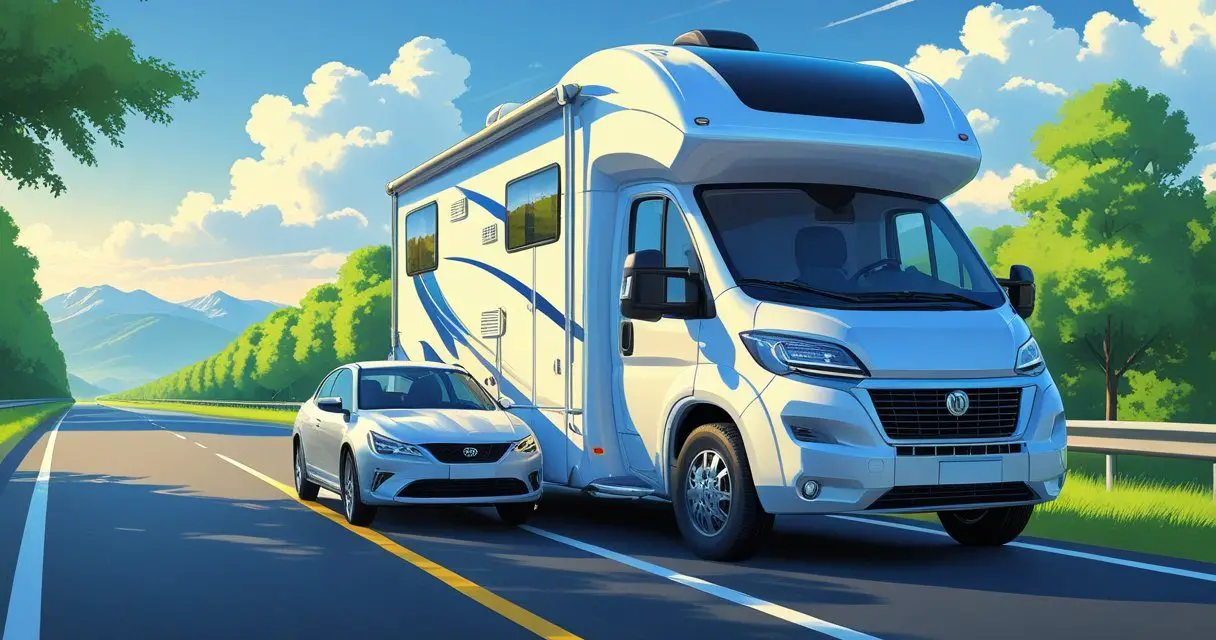Would you like to save this article?
Your RV adventure might be doomed before you even leave the driveway – and it’s not about what you think! Most people obsess over tow ratings and payload capacity, but there’s a sneaky little secret that could send you careening across three lanes of traffic faster than you can say “family vacation.”
Josh the RV Nerd from Bish’s RV just dropped some serious knowledge that every wannabe road warrior needs to hear. We’re talking about the wheelbase-to-trailer-length ratio – the safety factor that literally nobody talks about but could save your bacon (and your bumper). Buckle up, because these five eye-opening revelations will completely change how you think about RV towing safety. Trust us, your future self will thank you for reading this before you hit the highway.
1. The 110-to-20 Rule That Could Save Your Life (And Your Marriage)
Here’s the golden formula that Josh reveals: Start with 110 inches of wheelbase on your tow vehicle, and that safely handles a 20-foot trailer. For every additional 4 inches of wheelbase, you can add 1 foot of trailer length. It’s like a mathematical lifeline for RV safety!
The Science Behind the Sway: When a trailer pivots just 6 degrees off center, a longer trailer creates exponentially more force trying to push your vehicle sideways. Picture this: that same 6-degree movement on a 35-foot trailer versus a 20-foot trailer creates dramatically different physics – and dramatically different pants-wetting moments.
Wheelbase-to-Trailer Length Safety Chart
| Vehicle Wheelbase | Maximum Safe Trailer Length |
|---|---|
| 110 inches | 20 feet |
| 130 inches | 25 feet |
| 150 inches | 28 feet |
| 170 inches | 33 feet |
According to the RV Consumer Group, approximately 500,000 accidents occur annually due to trailer sway – many of which could be prevented by following this simple wheelbase formula.
Your Reality Check: You probably thought bigger meant safer, but that compact car with the tight turning radius? It’s basically a recipe for highway chaos when you hook up that dream trailer. The tighter your turning radius, the worse your towing control – it’s counterintuitive but absolutely true.
2. Half-Ton Trucks Are the Ultimate Wildcard (And Not in a Good Way)
“Can my half-ton tow this?” is literally the worst question you can ask – and Josh explains exactly why. Half-ton trucks have the most variable wheelbase range of any vehicle category, spanning from roughly 122 inches to 158 inches. That’s like asking “Can my mystery vehicle tow this mystery trailer?”
The Terrifying Truth About Half-Tons: The difference between a short-cab, short-bed half-ton and a crew-cab, long-bed version isn’t just about passenger comfort – it’s about fundamental towing physics. We’re talking about a 36-inch wheelbase difference that completely changes your safe trailer length.
Statistical Reality Check
- 75,000 people are injured annually in RV accidents according to the Federal Motor Carrier Safety Administration
- 26 deaths per year occur from RV-related crashes on average
- Over $35.6 billion in property damage has resulted from trailer-related accidents between 1975-2008
Your Wake-Up Call: You wouldn’t buy shoes without knowing your size, so why are you matching trailers to trucks without knowing the exact wheelbase? That “half-ton” label tells you absolutely nothing about towing control – it’s like calling every dog “medium-sized.”
3. SUVs: The Pretty Package Hiding an Ugly Towing Secret
Here’s where things get really sneaky: Some SUVs boast impressive tow ratings and powerful engines, but they’re built with short wheelbases for grocery store parking convenience. You’re essentially trying to control a long trailer with a vehicle designed for mall navigation.
The Lightweight Trailer Trap: Modern laminated RVs can give you more length for less weight – sounds perfect, right? Wrong! The reduced weight doesn’t matter one bit when it comes to that long tail wagging your SUV dog. Length pushes vehicles around regardless of weight.
Key SUV Towing Factors
- Shorter wheelbase = designed for tight parking spots
- Higher center of gravity = more susceptible to sway
- Lighter curb weight = easier to push around
- Marketing focus on power = ignores control physics
The Federal Motor Carrier Safety Administration reports that RV accidents increased from 70,000 incidents in 2003 to 75,000 injuries in 2012 – showing the trend is getting worse, not better.
Your Reality Check: You thought that powerful SUV with the 8,000-pound tow rating was your ticket to RV freedom, but it might actually be your ticket to the emergency room. Those grocery-getting wheels weren’t designed for highway stability with a house attached.
4. The “Subjective” Safety Zone That’s Anything But Safe
Unlike legal tow ratings where you’re either compliant or breaking the law, the wheelbase-to-length ratio operates in a gray zone that Josh calls “subjective.” Cross the recommended line and you won’t immediately lose control – you’ll just progressively lose it, especially at higher speeds, in windy conditions, or going downhill.
The Mountain Descent Reality: Everyone talks about getting up mountains with adequate tow ratings, but controlling your rig going DOWN mountains can be exponentially more terrifying. That extra trailer length becomes a physics nightmare when gravity gets involved.
Progressive Risk Factors
- Higher speeds = exponentially more dangerous
- Windy conditions = trailer becomes a sail
- Mountain descents = gravity + momentum + length = disaster
- Emergency maneuvers = when you need control most, you have it least
Statistical Insight: Studies show that inexperienced drivers cause the majority of RV accidents, and most states require no special training or licensing for RV operation despite the unique risks.
Your Harsh Truth: You’re basically flying blind in that subjective zone, gambling with physics until you discover your limits at 65 mph in a crosswind. That’s not adventure – that’s Russian roulette with a house attached.
5. The Transport Driver Secret That Proves Size Matters (But Not How You Think)
Josh points out a local RV transport driver with a long-bed, quad-cab setup – basically the longest possible truck configuration. Professional haulers choose maximum wheelbase for maximum control, not because they enjoy difficult parking but because their lives depend on stability.
The Weight vs. Length Reality: Heavier vehicles are harder to push around, which is why 3/4-ton and 1-ton trucks provide superior towing experiences beyond just their mathematical ratings. Physical mass fights physics better than wishful thinking.
Professional Towing Advantages
| Factor | Why It Matters |
|---|---|
| Maximum Wheelbase | Longest possible control arm |
| Heavy Curb Weight | Harder to push around |
| Professional Training | Understanding physics vs. guessing |
| Electronic Controls | Anti-sway technology backup |
According to analysis from the Fatality Analysis Reporting System, RV accidents have a lower fatality rate (0.44 per 100 million vehicle miles) compared to all vehicles (1.48 per 100 million) – but this doesn’t account for the terror factor of losing control. Fifth Wheel St
Your Professional Reality Check: You want to tow like a pro? Start thinking like a pro. Those transport drivers aren’t choosing the most inconvenient truck possible – they’re choosing the most controllable truck possible. Maybe your ego can handle a longer parking job if it means your family handles the highway safely.
The Bottom Line: Physics Doesn’t Care About Your Vacation Plans
Josh’s message is crystal clear: smaller RVs might mean smaller profits for dealers, but they definitely mean bigger safety margins for families. The math doesn’t lie, physics doesn’t negotiate, and your wheelbase-to-trailer ratio doesn’t care about your Pinterest board dreams.
Before you sign on the dotted line for that dream trailer, measure twice, calculate once, and remember: the most expensive RV is the one that puts you in the hospital. Your adventure should be memorable for the right reasons.
Ready to make smart towing decisions? Start with your vehicle’s exact wheelbase, apply the 110-to-20 rule, and choose safety over square footage. Your future self (and your insurance company) will thank you.
SOURCES
- Josh the RV Nerd – Vehicle Length & Wheelbase vs RV Length
- RV and Playa – RV Accidents Statistics: 19 Facts You Should Know
- Fifth Wheel St – RV Accidents and Statistics
- Federal Motor Carrier Safety Administration – RV Accident Studies
- Fatality Analysis Reporting System (FARS) – RV Safety Data
- RV Consumer Group – Wheelbase Guidelines





